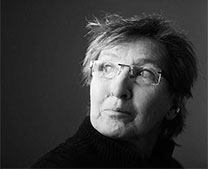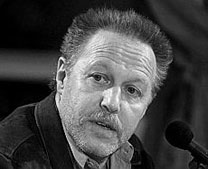


Forever

What a joyful visit to a cemetery! From the very beginning of this film I felt at home in the universe that Heddy Honigmann creates among the dead and the living. She visits some of the famous graves of Père Lachaise but she also walks around to meet people, she talks to them, she finds and sometimes follows their stories and she conveys them to us – so you feel content and in a good reflective mood when the film is over.
She starts like I have done so many times myself when I have visited Père Lachaise in Paris. You drop from place to place, look at the tombstones and mostly at the people, who either walk around like you do as a pure visitor or are occupied by watering flowers, cleaning the graves or are taking photos like yourself when you stand in front of the grave of Jim Morrison.
But then Honigmann demonstrates why she still is to be considered as one of the most interesting documentary makers of our time. From the impressionistic glimpses from the cemetery she goes deep to stress that this film is not a touristic trip but something diffferent.
She meets a young Japanese woman in front of the grave of Frédéric Chopin. The woman declares her love to music and tells us why Chopin is so painfully close to her heart. Honigmann leaves the cemetery to give us more information about the woman and makes her return to the film to sit behind the piano.
Many of the characters of Honigmann come back from time to time. The film has a loose structure where you go from intense situations to scenes where you can relax. The illusion is created that Honigmann meets the characters again and again in this film, that according to herself is about ”the importance of Art in Life”.
It is with this phrase that she answers the Iranian man who rests at the grave of the poet Sadeq Hedayat, when he asks what kind of film she is doing. She answers and returns the question to him, why are you here and at this specific grave. He is a taxidriver in Paris but music and poetry are his passions. Honigmann dares to pause, waits for his answers, the man grows in importance and reluctantly, but also happy about the conversation it seems, he ends up singing for us.
It takes intuition to be a good documentary filmmaker – Honigmann knew that he would sing if she waited! Time and patience brings poetry.
These were two unknown people with each their story connected to very well known artists. There are more of this kind. There is a sweet lady who nurses the graves of Marcel Proust and Apollinaire and Modigliani and knows their personal stories. There is the gentle man who is a guide in Père Lachaise and who takes us to a couple of graves where no-one comes. He can have them for himself, and he can dream and make the stories about them that he wants to. And there is a woman called Valerie who is taken from the grave of the painter to sit for herself in a museum in front of a painting of Ingres.
A film about the importance of Art in Life. Marcel Proust is dust but his literature is alive. ”Ars longa, vita brevis”. Yes, the film reminds us about the trut hof this sentence, absolutely and it does so in a very original and inventive way. I love the way the combination of the music of Petrucciani is made with the silent film clips of Méliès. I get tears in my eyes when I hear Maria Callas in a black & white archive piece from her singing Tosca. And the three blind (!) people who watch a Simone Signoret film followed legenatly by a cut to the tombstone of Simone Signoret and Yves Montand, who conquers the sound track to sing ”Le Temps des Cerises” put in a completely new visual context. And I will do my best, as several others promise when they stop at Marcel Proust, to read ”A La Recherche du Temps Perdu”!
But basically the film is about Life and Death. Of course you might say – it takes place in a cemetery. But it also takes place in your own head, you make your own associations. Existential questions are dealt with without any banalities and always with a respectful curiosity for the people, who open their hearts in front of the camera. The camera catches the situations, records them but does not go close to the women singing or reading for the ones in the graves. She does not intrude into the solemnity (højtidelighed) that also reigns at a cemetery when we go to meet those, who are no longer physically alive – and yet, alive they are in mind and heart. We fill the empty plastic bottles and bring them to where the flowers and the tombstones are. To bring back the memories.